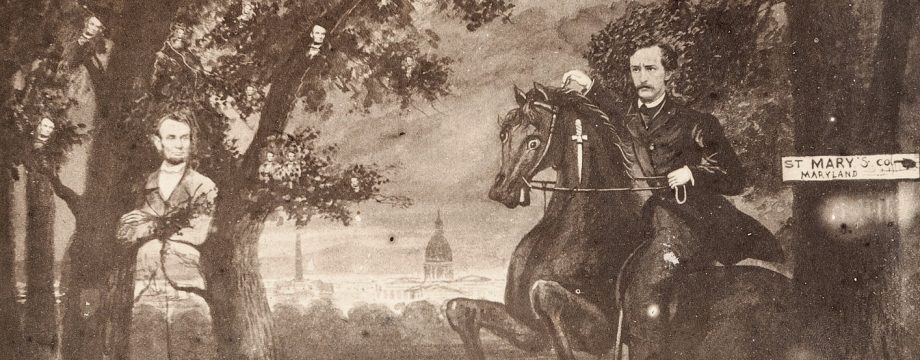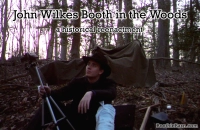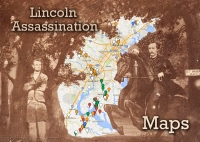Over May and June of this year, I presented a day-by-day project documenting the Trial of the Lincoln Conspirators. To further support usability of this project for students and researchers, I am releasing individualized tables of the testimony given at the trial relating to each conspirator. Rather than having to look through the entirety of the trial to gain an understanding of the specific evidence against a single person, all of the relevant testimony regarding each conspirator has been organized into an easily accessible and hyperlinked table. I have previously released the testimony regarding Mary Surratt, Lewis Powell, David Herold, George Atzerodt, Samuel Arnold, Michael O’Laughlen, Edman Spangler and finish today with Dr. Samuel Mudd. The text that follows this paragraph contains the same information that will always be found on a standalone page of the trial project called Dr. Samuel Mudd Testimony and can be accessed by clicking the picture of Mudd on The Trial homepage.
The following table shows all of the testimony given at the Lincoln conspiracy trial concerning Dr. Samuel A. Mudd. Clicking on any of the witnesses’ names will take you to their corresponding testimony in the chronological Trial project.
The default arrangement of the witnesses in the table is by Relevant Testimony. This organizes the witnesses based on what specific aspect of the conspirator’s case was discussed. In the case of Dr. Mudd, I organized the testimony into eight categories, labeled A – H. Descriptions of what each category means can be found after the table. The tabs on the bottom of the table allow you to view the witnesses arranged by Date and Alphabetically by last name.
Mobile users: Due to the smaller screen size on mobile devices, you will likely have to scroll left and right on the table to see the Relevant Testimony column.
Relevant Testimony descriptions:
A. Dr. Mudd Introducing John Wilkes Booth to John Surratt
The first witness to mention Dr. Mudd by name at the trial was Louis Weichmann, one of Mary Surratt’s boarders. Weichmann described how he and John Surratt were introduced to John Wilkes Booth by Dr. Mudd. It was through this introduction that Surratt joined the conspiracy and facilitated the recruitment of others like George Atzerodt and Lewis Powell. This introduction was, therefore, a big piece of the prosecution’s case in connecting Dr. Mudd to Booth’s plot. As damaging as this was, however, Weichmann made a huge error on the stand stating that the introduction occurred in January of 1865 and not on December 24, 1864 when it actually happened. As a result, Dr. Mudd’s defense brought many witnesses forward to establish Dr. Mudd’s whereabouts from December, 1864 to April, 1865 in order to counter Weichmann’s mistaken timeline.
B. Dr. Mudd’s Interactions with the Authorities
Some of the detectives who visited and searched the Mudd house after the assassination made the accusation that Dr. Mudd denied having been visited by anyone on April 15th. This led the defense to bring forward witnesses showing that Dr. Mudd not only complied with the authorities who visited him, but also alerted some of his neighbors concerning the “strangers” who had sought medical attention from him.
C. Booth with Dr. Mudd in 1864
John Wilkes Booth visited Charles County and met Dr. Mudd in November of 1864. He returned to the area in December. During these visits, Dr. Mudd helped Booth purchase the horse that was later used by Lewis Powell on the night of the assassination. The defense tried to explain these interactions by showing how Booth was looking to buy land in the area.
D. Dr. Mudd Threatening Lincoln
One of Dr. Mudd’s neighbors, Daniel Thomas, testified that in March of 1865 he heard Dr. Mudd threaten the life of President Lincoln. According to Thomas, Dr. Mudd claimed that Lincoln, his cabinet, and all Union men in Maryland would be dead in a couple of weeks. Dr. Mudd’s defense called a plethora of witnesses to testify to Thomas’ unreliability and desire for reward money.
E. Dr. Mudd and David Herold Riding to Bryantown
Becky Briscoe, one of the prosecution witnesses, claimed she saw David Herold wait outside of Bryantown on April 15 as the doctor visited the town. The defense provided witnesses who agreed that Mudd was somewhat accompanied by Herold as he rode to Bryantown, but that Herold turned back and went back to the Mudd farm alone.
F. Dr. Mudd Learning about the Assassination in Bryantown
Prosecution witnesses charged that the identity of Lincoln’s assassin was well known in Bryantown when Dr. Mudd visited on April 15 with two of Mudd’s neighbors testifying that the doctor told them about it. The defense brought many Charles County residents who claimed there was much uncertainty at the time.
G. Dr. Mudd’s Disloyalty and Harboring Confederates
Many of those formerly enslaved by Dr. Mudd testified about his pro-Confederate attitudes and cruel treatment. Several alleged that Dr. Mudd allowed Confederate agents to hide out on his property. His defense stated that Dr. Mudd only allowed a group of men to hide on his property near the beginning of the war because they were concerned about being arrested.
H. Dr. Mudd in D.C. on March 3, 1865
Two prosecution witnesses, Rev. Evans and Marcus Norton, claimed to have seen Dr. Mudd in Washington, D.C. on March 3, 1865. Evans stated he saw Dr. Mudd entered Mrs. Surratt’s boardinghouse while Marcus Norton claimed Dr. Mudd barged into Norton’s room at the National Hotel thinking it was John Wilkes Booth’s. Dr. Mudd’s defense brought several witnesses to speak to the unreliability of these men and to show that Mudd was on his farm during the period in question.
For the closing argument in defense of Dr. Samuel Mudd please click here.
Please remember that the Relevant Testimony descriptor is not meant to be definitive. In many instances, a witness might cover material from more than one category. For example, many Charles County witnesses were asked about their opinion of prosecution witness Daniel Thomas even if their main testimony was about a different aspect of Dr. Mudd’s case. Still, the attempt has been made to determine the most applicable category for each witness’s overall testimony.






Recent Comments